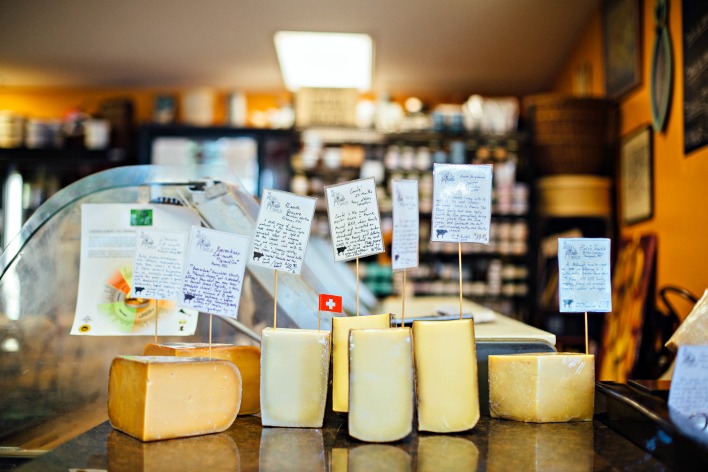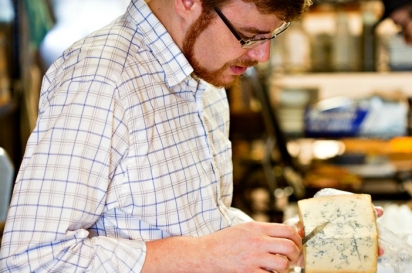The Cheese Traveler
There is actually a word for connoisseur or lover of cheese: “turophile.”
But Eric Paul, turophile and cheesemonger extraordinaire, didn’t teach me that tidbit on a recent trip I made to his charming Albany shop, the Cheese Traveler. What I did learn is this: “fromage,” the French word for cheese, emanates from the ancient Greek word “forma,” which means “to form” and refers more specifically to the container a cheese was molded in. If we look instead to the Latin root “cāseus,” which means “to ferment,” it gives us the words “queso,” “casein” and of course ... “cheese.”
But I digress.
Since 2012, the Cheese Traveler has been a one-stop destination for lovers of cheese, with a wide choice of craft provisions to accompany your selection.
The store is neatly divided into two sections. When you walk in the door, the cheese case is located front and center. Imported cheeses are displayed to the left and domestic to the right, about 100 types at any one time, except for the holiday season, when the amount swells to 125. You can taste anything. There is a well-stocked rack of condiments; sweet and savory jams and preserves with delectable flavors such as Whisky-Seville Orange, Raspberry-Jalepeño and Blueberry-Bourbon, to name a few. These complement the cheeses on made-to-order sandwiches that can be enjoyed in-house or for takeaway. You can buy fresh artisanal bread and crackers galore.
Sashay to the left and it’s almost like you’re in a second shop. Lining the wall is a wide and diverse selection of craft beers, both imported and domestic, from small-batch producers of fermentation voodoo. Eric has taken care to choose beers that pair well with cheese. There are also scores of traditional European ciders, as well as American ciders from small-scale orchards that adhere to traditional cidermaking methods.
There is a unique mixology section with bottles of bitters, syrups, tonic water and cherries for the types of cocktails a foodie might mix up. In other words, no high-fructose corn syrup here. Spin around and there is an olive bar, behind which are dry provisions and bottled goods: Rancho Gordo beans from California, an array of McClure’s pickles, bronze-cut pastas, olive oil, cured fishes and more. The back coolers are filled with pastured, local meats from Tilldale Farm, Hessian Hill Farm and other local purveyors.
The store has an on-premise tavern license, a boon if you want to slake your thirst while enjoying a sandwich at one of the bistro tables. You won’t get an ordinary grilled cheese but, rather, an inspired concoction created by chef Ryan Skrabalak, who also cooks at Garden Bistro 24 in Latham. Consider the “Sweet and Savory”: Pawlett cheese from Vermont with smoked duck breast and berry preserves on ciabatta; or the “Spicy and Smoky”: pecorino sardo, ’nduja (spicy spreadable salumi) with grilled artichokes and onion on semolina olive sourdough. A basic grilled cheese called the “Simple Pleasure” is always available, though I know—I just know—it tastes nothing like the grilled cheese your mom used to make.
Mr. Paul started small. At first the Cheese Traveler didn’t even have regular hours but instead just posted on Facebook when it would be open for customers. He filled the store half a shelf at a time, starting with 70 cheeses and two coolers. He took orders. And eventually there was a steady stream of customers.
An array of different cheeses are being curated all the time, and there has been a turnover of almost 400 varieties in inventory since the store opened. The seasonal stock varies year round, a new concept for me regarding cheese. After all, in a supermarket, the cheeses never change beyond the customary nut-studded holiday cheese ball. Things are different here.
He brings out a tray of Robiola di Capra Incavolata, a young goat’s milk cheese, each one wrapped in pale-green cabbage leaves and prettily tied with raffia. The cabbage prevents the cheese from drying out, he explains, since there is no rind. Cheese absorbs the aromatic flavor of the leaves it is wrapped in, be it cabbage, fig or chestnut. It’s a wonderful example of a seasonal cheese. Another fine example is the Alpine blues released on the summer equinox. On the other hand, he tells me, there are some delicate cheeses that cannot be shipped in warm weather, so they are only available in colder months.
I will never look at cheese the same way again.
I ask Eric what he is most passionate about when it comes to cheese and it gives him pause ... for just a heartbeat. But then he starts to talk. He is enthusiastic about small-scale traditional-style cheese, cheese that is “born of a place.” It is important to know the history, the climate, even the topography of a region where cheese is from, and he is eager to be the one to tell you.
He fascinates me with details about cheeses from Spain that are predominantly made from sheep or goat’s milk. This livestock only grazes on sage bush in that arid land largely devoid of pasture for cows. Then he shocks me with the historical fact that, during World War II, Hitler ordered Italy’s water buffalo herds slaughtered so that cheese could not be produced. There is no end to this man’s knowledge.
Traditional cheesemaking is all about attention to detail. In America, traditions are learned and often tinkered with; an example of this is fusion cooking. Many domestic cheese producers don’t know cheesemaking traditions or where they emanate from; the history of, the methods of, he says. Eric is a student of tradition, and carefully selects cheeses that represent different styles and traditions of the world. “For example, the French have been making Fourme d’Ambert, a traditional blue cheese made from cow’s milk in the Auvergne region, the same way for 2,000 years. We want to be able to talk about and share these traditions.” The current breakdown of cheese in the store is 40% domestic (never say American cheese!) and 60% imported. The majority of domestic cheeses are from New York (the Adirondacks, Washington County, Hudson Valley, Central Leatherstocking and the Finger Lakes regions) and Vermont, as well as several from Wisconsin and across the country. Most imported varieties hail from France, Italy, Britain and Switzerland.
The Cheese Traveler offers some fun and engaging opportunities for customers to sample its fare. From May to September, the grill gets fired up and tables appear outdoors for the popular barbecue cookouts in the parking lot. Patrons can order from a rotating menu that includes burgers, corn and potato dishes, and of course, cheese and charcuterie platters. There are also guided tasting classes, unique in that they are structured by a theme or micro-region. For example, a Bastille Day class features a flight of French wine or cider combined with an assortment of French cheeses and condiments. A micro-region class might highlight a remote area such as Jura, the wine-producing Alpine region in eastern France. Classes feature four to five wines, ciders or beers, paired with cheeses and condiments.
A couple of 20-something guys walk in. “Hey, do you have any Brabander Goat Gouda?” Huh? You’d expect these guys to be asking for sliced American or Swiss, but not here. Eric jumps up to help. What we have, he tells them, is made specifically for the best cheese shop in Holland. (What I discover, upon further research, is that L’Amuse Brabander Goat Gouda is an artisan aged goat’s milk Gouda, not the typical Gouda that is made from cow’s milk. These guys knew what they were looking for.) Eric takes time and interest with each customer.
The Cheese Traveler, firmly rooted in Albany, seeks to transport its clientele anywhere in the world, via a flight of craft beer or cider and the delicious flavor of cheese.







